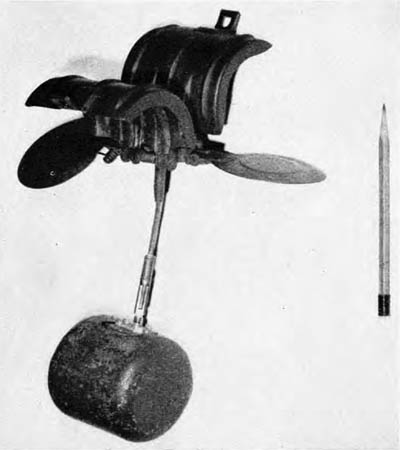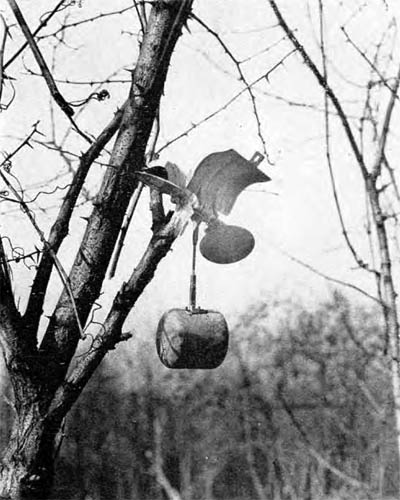A warning about the dangers of the WWII German “Butterfly Bomb” (Sprengbombe Dickwandig 2 kg or SD2) from Booby Traps, Bureau of Naval Personnel, Navy Department, Washington D.C., 1944.
German “Butterfly Bomb”
The “butterfly bomb” is the German’s favorite bomb against personnel on beaches, in camps, and against airfields. It is small and light, and can be dropped in great numbers from airplanes. One plane can carry several hundred of these deadly little devices with no trouble at all. As each bomb descends, the fist-sized iron ball full of explosives swings free at the bottom of a rod about the size of a lead pencil. The unfolded fins on the top of the pencil-rod are whirling in the air and turning the rod, thus arming the bomb.
Some “butterfly bombs” explode in the air just above ground, some on hitting the ground, and some incorporate delayed action (about 8 to 30 minutes) which makes everything just dandy for the persons who have to come out after the raid to fight fires. See figs. 8 and 9. That should be enough, but the end is not yet. Part of the crop of “butterflies” will not go off at all until someone disturbs them—picks them up, treads on the wings, or the like. Often the bodies of the bombs will have buried themselves in the soft earth. The only part visible will be the brightly colored (green and red, or green and yellow) upturned wings, like the lovely discarded shells of some crabs or lobsters. What a memento for the office desk back home—but pick it up and you won’t get back home!
As an example of how the “butterfly” can let you down: One night last spring in North Africa the Germans raided a forward area of ours where there happened to be a P.O.W. (prisoner of war) cage full of Germans we had captured that day. Jerry dropped hundreds of “butterfly bombs” and one of them drifted into the P.O.W., settling to earth without going off. Naturally the German prisoners were greatly relieved and shied clear of their own infernal machine. But next morning was a different story. Three of our allied soldiers guarding the P.O.W. came across the little yellow wings, and the pencil rod, and the iron ball.
Figure 8. Danger lurks for the inquisitive in the form of the German anti-personnel bomb known as the “butterfly.” Here is one of these bombs, lying as you might find it in the field.
“A-ha!” said one of the guards to his pals. “Something new has been added.”
And while the other two held onto the little iron ball, he tried to unscrew the yellow wings, and up went all three—the German prisoners, watching from a distance, were delighted.












The device always fascinated me but cause of the complexity of the way it worked; it’s hard to understand how someone came up with the idea.
The ones going off in the air sound like they are malfunctioning,as the whole point of this device is as a surface detonating anti-personal weapon.
If imitation is the sincerest form of flattery, the the US M83 cluster bomb submunition really flattered the German designers:
http://www.inert-ord.net/usa03a/usa6/bfly/index.html
That one did indeed have some sort of air-burst fuze installed, thought to get it to work at the right altitude and still keep the bomblet simple must have been a difficult challenge.
Was it Splitterbombe or Sprengbombe
An excellent post. Thank you.
Very helpful post, thanx for the info.
Early in 1941, a few months after our R.A.F. Station had been brought to a virtual shutdown as a result of hundreds of “Butterflies” being dumped upon us, an airman walked up to the Guardroom holding “something” he had found in some nearby woods. As calmly as I could, I advised him to go back to a grassy space and place the “something” on the ground. Fortunately it went off without a hitch. Surrounded by sandbags it was safely detonated. This was long after we had lost two senior armourers trying to turn back the Zeit pointers
Very informative, thank you very much! Image of device near pencil is nice to show real size.
Question to Denis O’ Keefe.
Would it be possible to talk a little more about your experience with Butterfly bombs via e.mail for an article I am writing. If so please e.mail j.i.rogers@2012.hull.ac.uk
Many thanks,
James Rogers,
Denis or anyone else, I was given a butterfly bomb and was told it was disarmed, however, I didn’t know if you knew for sure how to tell if it is safe to display? It is yellow paint and it has a red stripe of paint on each wing. I was told the red stripe was added to let people know it was disarmed.
Thanks.
Dear Jon,
I suggest calling the police and getting bomb disposal involved as a first port of call, it is not worth the risk.
This may sound dramatic, but it is the commonsensical next step. I have done a lot of work with these cluster bombs and my only advice to you is that they are very sensitive!
If you have any doubt at all that it may be armed you must not touch or tamper with it! Many are set with anti disturbance fuses (just like a landmine) thus any movement, at any time may arm it. Also the fuse may have jammed and again any movement may set it off.
If you choose not to call the police and get bomb disposal to check it out ( which I very much recommend you do, below is the contact details for Steven Venus. He is an expert on WW2 bombs and bomb fuses. If you do not wish to contact him then his website is also linked below. You may be able to find the information you want there.
Steven Venus E.mail: G6uxn@btinternet.com
Steven Venus Website: http://www.bombfuzecollectorsnet.com/
Good luck,
James